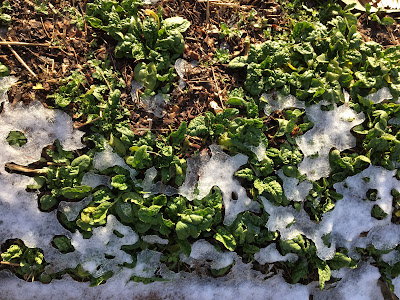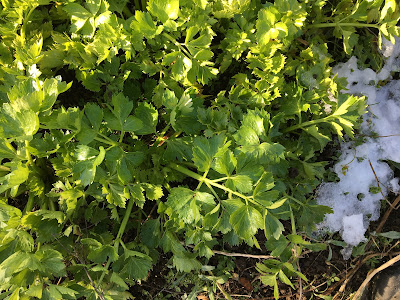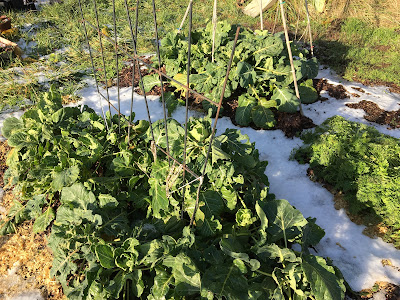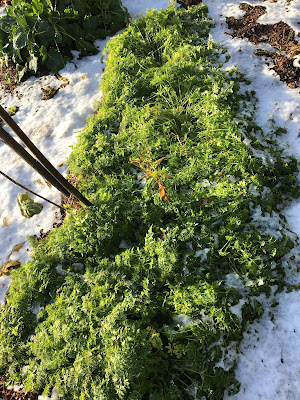It's been a few weeks since we had snow, in fact it was on the day of the Winter Solstice (December 21) that it snowed. The snow was very slow to melt on our property and temperatures lingered down in the low to mid 30s for a week. I took photos at that time of our garden and neglected to post them. As I was looking through my camera roll this morning, I realized these photos are worth sharing.
I didn't really understand until just last year that certain cool season crops overwinter. This year's fall and winter garden is an experiment, as we are curious to learn how well all of these veggies will do outside on our property. Our weather here tends to be in the 30s most of the winter, and we'll also get some temperatures in the 20s in late January and throughout February. So far, the veggies are hanging in there!

Lettuce is one of my favorite cool season crops! It's so quick to bolt in the hot summer sun and it also tends to get bitter as the leaves get larger and older. In fall and winter, the lettuce slows waaaay down, growing at a snail's pace. It also stays very sweet. We have been picking a bowl full of lettuce every couple days for enjoying fresh, homegrown salad greens with our dinners. There are no pests bothering our lettuce so far, either, unlike in the summer when snails and slugs made a feast of these greens. I'm growing a wide variety of salad greens out there and they are all doing very well.
Kale is also doing exceptionally well in the cold weather. No bugs are munching on these leaves, either! We are adding kale to our salads, putting kale on our homemade pizzas and throwing handfuls into soups as well. I froze a bunch of kale during the summer, but we haven't had to break into the frozen kale yet since we have fresh kale growing outside in our winter garden!

Lovely green leaves of spinach, so tender and delicious, are growing very nicely out in the garden. I've had to sprinkle some iron phosphate (Sluggo is the brand we use) on these to keep some sort of pest from eating these. Tiny slugs? Snails? I haven't actually seen the little buggers, but the evidence of their feast is seen in the tiny holes and munched edges on some of the leaves. Iron phosphate occurs naturally in soil and so it's an organic way to control such pests. As you can see, however, spinach grows very nicely in the winter. Like the kale, we are enjoying garden fresh spinach in soups, on pizza, in salads and also with various egg dishes.

Above is one of the patches of celery! It's growing in the snow! This patch was planted last spring for a friend and unfortunately in the hot summer sun it didn't do all that well. In fact, we hardly ate any of it and I was disappointed in celery, thinking perhaps it didn't grow well here. Now, with the cooler weather, the celery has grown twice as big and looks fantastic. The stems are very tender and sweet. I had no idea celery was a cool season crop. We're curious what will happen to the celery once temperatures dip down into the 20s. I'm rooting for it now, way to go celery!
You may not recognize the mass of green above. Believe it or not, those are carrots. The snow caused the green tops of the carrots to slump over, but they perked back up after all the snow was gone. Carrots clearly do very well in cool weather and snow.

Cauliflower also survives the snow, but beware of the pests that eat it this time of year. Whatever is eating the spinach is munching twice as hard on the cauliflower, shown above. Iron phosphate helps, but you have to keep adding more around the plants every couple weeks to keep up with those annoying little buggers!
Above is one of our broccoli plants. It's been struggling, but not due to the cold. Something is chewing on it. I would say that trying to overwinter broccoli and cauliflower is a good idea, but likely we're only doing so to have an earlier crop in the spring. Maybe by very early spring we'll have something worthwhile from these plants.
This is the first year we've grown Brussels sprouts, and they are actually just now starting to get visible sprouts growing along their stalks, as you can see above. I'm anticipating we will be enjoying these in late January or early February. Below are two of the patches of Brussels sprouts that I planted.

Cilantro (photo below) reseeded itself throughout the garden. I have been digging up and transplanting the cilantro into one area, so it's not scattered everywhere. In doing so, I've learned that cool season crops don't mind being transplanted this time of year. The plants quickly recover being uprooted and continue growing. It's wonderful to have fresh cilantro in the garden any time we want some. Another herb that is doing exceptionally well is parsley, which is growing all over in the garden, too (I forgot to take a photo). Parsley grows in our garden like an invasive species. We have more parsley than we could ever be able to consume.
Below is more spinach along with Swiss chard. We haven't been able to kill our Swiss chard, and believe me, I've dug it out and tossed it a few times. New plants keep appearing. I've loved it and hated it at times. It's easy to become overwhelmed by Swiss chard in the summer, when the plants get enormous, shading other plants you're trying to grow, and then the Swiss chard will suddenly bolt, producing seeds that blow all over the garden. Of course, you can always cut off the enormous stalk of flowers and seeds to prevent the plant from spreading all over the garden. In the winter when there are fewer veggies available to pick in the garden, Swiss chard is a welcome sight. Garden pests also enjoy munching on Swiss chard leaves during the winter.
Beets (below) are doing just fine out in the garden. They've slowed their growth substantially. Most of the leaves are now turning a reddish color as well. Underneath the soil, the beet root is healthy and we've found that they don't get woody in texture in the winter.
Above, peas are climbing up the chicken wire and we've seen a few flowers and peas forming despite the cold. Freezing weather causes the pea to turn brown and soft and so don't expect to eat any peas off the plants once the temperature has dropped down below 32 degrees F. However, the pea plant - all those lovely green shoots and leaves - are hardy enough to withstand the frost and they keep on growing. I'm expecting that once we stay above freezing and early spring is here, our pea plants will be full sized and will start giving us lots of wonderful peas. By growing them over the winter, we might be able to have a harvest earlier than ever before. Keeping our fingers crossed!
There is one change I would make when growing cool season crops. I would plant them earlier. I waited to plant them until we had rain, because it can be hard to start cool season crops when it's hot outside. Because of this, we didn't plant many of these veggies until August and September, and as you can see the plants are small. Once our weather took a nosedive in mid-October, the pace of plant growth stalled. If the plants were all nice and big in mid-October, we would be harvesting much more food right now. We eat a lot of vegetables. While we did freeze, can and dehydrate a substantial amount of summer veggies for the winter, we've already eaten up many of them, which means we now have to supplement what we harvest with organic veggies and salad greens that we're purchasing from the grocery store. Imagine how wonderful it would have been if everything we needed could come out of our garden. This next summer, I will try planting cool season crops in July. Additionally, I'll start the plants in the greenhouse so that I'm putting full sized plant starts in the ground rather than seeds, and we'll add a heavy mulch on top to keep them moist in the hot summer sun.

The photo above isn't all that pretty, but I wanted to show you what we're using for weed barrier and share how we're following a plan of continuous gardening. It used to be that once fall arrived, we "buttoned up" the garden (basically, we tore out all the old plants and tidied up things, then called it good until next year). Then we didn't set foot in it again until the spring, other than perhaps to put some manure compost on the garden in late fall or early winter. When spring came around, we tilled up the whole garden and I dug new rows. Not anymore. Nowadays, we are out there in the garden regularly, at least every other day, harvesting, weeding, and putting kitchen compost and weed barrier out.
We're experimenting with a different composting and weed barrier method. We are burying our kitchen compost directly into the garden. I just dig a hole in one of the unused beds, dump my kitchen scraps in the hole, add wood ash from the fireplace, and cover it up with dirt. After a few rows have been amended with kitchen scraps and wood ash, then I get a wheelbarrow full of manure compost and spread it across the top of each row. If we've gotten any plain brown boxes such as from an Amazon order, those get broken down and put into the aisle between the rows as weed barrier. We put rocks or pots on top of the cardboard so the wind doesn't blow it around. When the chicken coop is cleaned out, the soiled hay or pine bedding gets placed on top of the cardboard in the aisle, where it can break down to become used as mulch around plants in a year or so. As we've been cutting firewood this winter, I've been putting the sawdust around the plants. In other words, we're trying to immediately put whatever we have out into the garden, rather than piling it anywhere else. We are doing it this way because we've found that our compost and mulch doesn't ever seem to make it out to the garden if we put it somewhere else.
Composting in this way gets us out into the garden nearly every day. While I'm out there, I pick some veggies for cooking with. Then I pull a few weeds. If I notice garden pests, I do something about them. As a result, our garden is staying tidier and the rows are becoming more fertile and ready for planting in the spring. I'm slowly making my way around the garden to clean up overgrown beds. It's allowing me to do a little bit at a time, all winter long, rather than one enormous effort in early spring. We'll be able to have a jump start on the growing season in the spring, which we are hoping will result in greater abundance from hardier plants. We'll keep you posted on how this experiment is going. You can read more about this in
The Garden Journal as well.














Comments
Post a Comment
Thank you so much for submitting a comment! All comments are reviewed by our moderator before being posted to the blog, in an effort to help control spam.